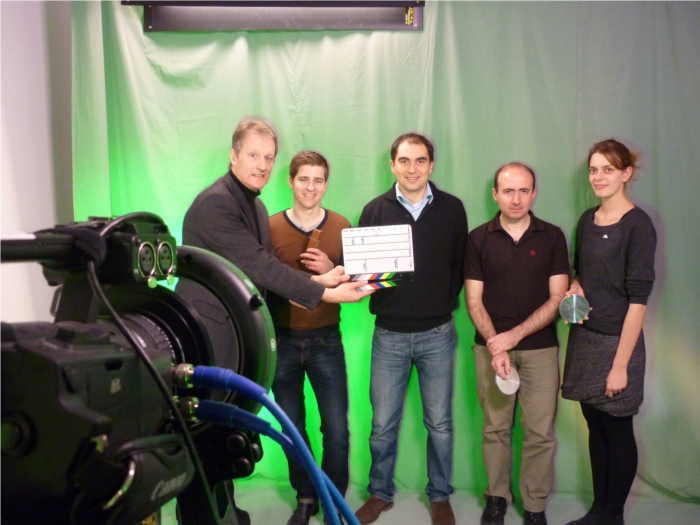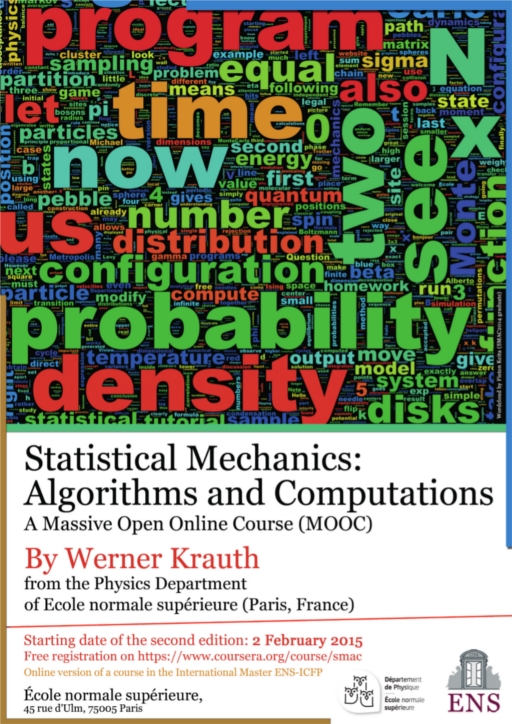MOOC SMAC
From Werner KRAUTH
| Revision as of 15:16, 9 June 2015 Werner (Talk | contribs) (→Syllabus) ← Previous diff |
Revision as of 15:18, 9 June 2015 Werner (Talk | contribs) (→Syllabus) Next diff → |
||
| Line 20: | Line 20: | ||
| Here is a list of the topics of the ten weeks. For each week, you can also find the sections of the SMAC text book where useful material can be found (NB: SMAC = W. Krauth - Statistical Mechanics: Algorithms and Computations, Oxford 2006) | Here is a list of the topics of the ten weeks. For each week, you can also find the sections of the SMAC text book where useful material can be found (NB: SMAC = W. Krauth - Statistical Mechanics: Algorithms and Computations, Oxford 2006) | ||
| - | WEEK 1 (starting FEBRUARY 2, 2015) | + | ==WEEK 1 (starting FEBRUARY 2, 2015)== |
| + | |||
| Lecture: Introduction to Monte Carlo algorithms | Lecture: Introduction to Monte Carlo algorithms | ||
| + | |||
| Tutorial: Exponential convergence and the 3x3 pebble game | Tutorial: Exponential convergence and the 3x3 pebble game | ||
| + | |||
| Homework: From the one-half rule to the bunching method (peer-graded, due on Sunday, February 15, 2015) | Homework: From the one-half rule to the bunching method (peer-graded, due on Sunday, February 15, 2015) | ||
| Relevant SMAC sections: 1.1.1 (children game - direct sampling), 1.1.2 (adults game - Markov-chain sampling), 1.1.4 (pebble game, detailed balance and transfer matrix), 1.3.5 (error estimates and bunching), 1.4.1 (ergodicity) | Relevant SMAC sections: 1.1.1 (children game - direct sampling), 1.1.2 (adults game - Markov-chain sampling), 1.1.4 (pebble game, detailed balance and transfer matrix), 1.3.5 (error estimates and bunching), 1.4.1 (ergodicity) | ||
| - | WEEK 2 (starting FEBRUARY 9, 2015) | + | ==WEEK 2 (starting FEBRUARY 9, 2015)== |
| + | |||
| Lecture: Hard disks: from Classical Mechanics to Statistical Mechanics | Lecture: Hard disks: from Classical Mechanics to Statistical Mechanics | ||
| + | |||
| Tutorial: Equiprobability, partition functions, and virial expansions for hard disks | Tutorial: Equiprobability, partition functions, and virial expansions for hard disks | ||
| + | |||
| Homework: Paradoxes of hard-disk simulations in a box (peer-graded, due on Sunday, February 22, 2015) | Homework: Paradoxes of hard-disk simulations in a box (peer-graded, due on Sunday, February 22, 2015) | ||
| Relevant SMAC sections: 2.1.1 (molecular dynamics), 2.2 (equiprobability), 2.2.1 (direct sampling for hard disks), 2.2.2 (partition function, acceptance rate, virial expansion), 2.2.3 (Markov-chain sampling for hard disks). | Relevant SMAC sections: 2.1.1 (molecular dynamics), 2.2 (equiprobability), 2.2.1 (direct sampling for hard disks), 2.2.2 (partition function, acceptance rate, virial expansion), 2.2.3 (Markov-chain sampling for hard disks). | ||
| - | WEEK 3 (starting FEBRUARY 16, 2015) | + | ===WEEK 3 (starting FEBRUARY 16, 2015)=== |
| + | |||
| Lecture: Energy, free energy, and phase transitions | Lecture: Energy, free energy, and phase transitions | ||
| + | |||
| Tutorial: Entropic interactions and the Random Clothes-pins model | Tutorial: Entropic interactions and the Random Clothes-pins model | ||
| + | |||
| Homework: Two-dimensional phase transitions (peer-graded, due on Sunday, March 1st, 2015) | Homework: Two-dimensional phase transitions (peer-graded, due on Sunday, March 1st, 2015) | ||
| Relevant SMAC sections: 6.1.1 (random clothes-pin), 6.1.2 (depletion interaction) | Relevant SMAC sections: 6.1.1 (random clothes-pin), 6.1.2 (depletion interaction) | ||
| Recreational multiple choice: Spotting a correct algorithm | Recreational multiple choice: Spotting a correct algorithm | ||
| - | WEEK 4 (starting FEBRUARY 23, 2015) | + | ==WEEK 4 (starting FEBRUARY 23, 2015)== |
| + | |||
| Lecture: Sampling and Integration - From Gaussians to the Maxwell and Boltzmann distributions | Lecture: Sampling and Integration - From Gaussians to the Maxwell and Boltzmann distributions | ||
| + | |||
| Tutorial: Sampling discrete and one-dimensional distributions | Tutorial: Sampling discrete and one-dimensional distributions | ||
| + | |||
| Homework: Sampling and integration in high dimensions (peer-graded, due on Sunday, March 8, 2015) | Homework: Sampling and integration in high dimensions (peer-graded, due on Sunday, March 8, 2015) | ||
| + | |||
| Relevant SMAC sections: 1.2.1 (random number generator), 1.2.3 (discrete distributions, tower sampling), 1.2.4 (connection between sampling and integration), 1.2.5 (sampling a Gaussian), 1.2.6 (sampling a sphere or its surface), 2.2.4 (Maxwell distribution of velocities). | Relevant SMAC sections: 1.2.1 (random number generator), 1.2.3 (discrete distributions, tower sampling), 1.2.4 (connection between sampling and integration), 1.2.5 (sampling a Gaussian), 1.2.6 (sampling a sphere or its surface), 2.2.4 (Maxwell distribution of velocities). | ||
| WEEK 5 (starting MARCH 2, 2015) | WEEK 5 (starting MARCH 2, 2015) | ||
| + | |||
| Lecture: Density matrices and path integrals | Lecture: Density matrices and path integrals | ||
| + | |||
| Tutorial: Trotter decomposition and quantum time-evolution | Tutorial: Trotter decomposition and quantum time-evolution | ||
| + | |||
| Homework: Quantum statistical mechanics and Quantum Monte Carlo (peer-graded, due on Sunday, March 15, 2015) | Homework: Quantum statistical mechanics and Quantum Monte Carlo (peer-graded, due on Sunday, March 15, 2015) | ||
| + | |||
| Relevant SMAC sections: 3.1.1 (quantum harmonic oscillator, wave functions, energy levels, density matrix), 3.1.2 (density matrix in free space and in a periodic box), 3.1.3 (density matrix in a box with periodic/open boundary conditions), 3.2.1 (Trotter formula, convolution of density matrices), 3.3 (path-integral formulation), 3.3.1 (path integral Monte Carlo) | Relevant SMAC sections: 3.1.1 (quantum harmonic oscillator, wave functions, energy levels, density matrix), 3.1.2 (density matrix in free space and in a periodic box), 3.1.3 (density matrix in a box with periodic/open boundary conditions), 3.2.1 (Trotter formula, convolution of density matrices), 3.3 (path-integral formulation), 3.3.1 (path integral Monte Carlo) | ||
Revision as of 15:18, 9 June 2015
Contents |
2014 Edition

The Massive open online course (MOOC) on Coursera: Statistical Mechanics: Algorithms and Computations, that started on February 3rd, 2014, and drew 30,000 registered students, is now finished. The last of the ten courses was published on April 13, 2014, and the final exam ran until 14 May, 2014. The course videos were viewed 250,000 times, thousands of homeworks were handed in, and there were about 5200 (!) entries on the forum that were viewed far more than 120,000 times, all of this of course for free.
The story of our MOOC was written up in an editorial "Coming home from a MOOC" for "Computing in Science & Engineering" (2015).
2015 Edition

The 2nd edition of the Massive open online course (MOOC) on Coursera: Statistical Mechanics: Algorithms and Computations ran from February 2nd, 2015 through May 26, 2015. Again a great experience, with a new enthousiastic crowd of students. Leave feedback on Twitter under the hashtag #SmacMOOC2015. The third edition will start on February 1st, 2016.
Syllabus
Here is a list of the topics of the ten weeks. For each week, you can also find the sections of the SMAC text book where useful material can be found (NB: SMAC = W. Krauth - Statistical Mechanics: Algorithms and Computations, Oxford 2006)
WEEK 1 (starting FEBRUARY 2, 2015)
Lecture: Introduction to Monte Carlo algorithms
Tutorial: Exponential convergence and the 3x3 pebble game
Homework: From the one-half rule to the bunching method (peer-graded, due on Sunday, February 15, 2015) Relevant SMAC sections: 1.1.1 (children game - direct sampling), 1.1.2 (adults game - Markov-chain sampling), 1.1.4 (pebble game, detailed balance and transfer matrix), 1.3.5 (error estimates and bunching), 1.4.1 (ergodicity)
WEEK 2 (starting FEBRUARY 9, 2015)
Lecture: Hard disks: from Classical Mechanics to Statistical Mechanics
Tutorial: Equiprobability, partition functions, and virial expansions for hard disks
Homework: Paradoxes of hard-disk simulations in a box (peer-graded, due on Sunday, February 22, 2015) Relevant SMAC sections: 2.1.1 (molecular dynamics), 2.2 (equiprobability), 2.2.1 (direct sampling for hard disks), 2.2.2 (partition function, acceptance rate, virial expansion), 2.2.3 (Markov-chain sampling for hard disks).
WEEK 3 (starting FEBRUARY 16, 2015)
Lecture: Energy, free energy, and phase transitions
Tutorial: Entropic interactions and the Random Clothes-pins model
Homework: Two-dimensional phase transitions (peer-graded, due on Sunday, March 1st, 2015) Relevant SMAC sections: 6.1.1 (random clothes-pin), 6.1.2 (depletion interaction) Recreational multiple choice: Spotting a correct algorithm
WEEK 4 (starting FEBRUARY 23, 2015)
Lecture: Sampling and Integration - From Gaussians to the Maxwell and Boltzmann distributions
Tutorial: Sampling discrete and one-dimensional distributions
Homework: Sampling and integration in high dimensions (peer-graded, due on Sunday, March 8, 2015)
Relevant SMAC sections: 1.2.1 (random number generator), 1.2.3 (discrete distributions, tower sampling), 1.2.4 (connection between sampling and integration), 1.2.5 (sampling a Gaussian), 1.2.6 (sampling a sphere or its surface), 2.2.4 (Maxwell distribution of velocities).
WEEK 5 (starting MARCH 2, 2015)
Lecture: Density matrices and path integrals
Tutorial: Trotter decomposition and quantum time-evolution
Homework: Quantum statistical mechanics and Quantum Monte Carlo (peer-graded, due on Sunday, March 15, 2015)
Relevant SMAC sections: 3.1.1 (quantum harmonic oscillator, wave functions, energy levels, density matrix), 3.1.2 (density matrix in free space and in a periodic box), 3.1.3 (density matrix in a box with periodic/open boundary conditions), 3.2.1 (Trotter formula, convolution of density matrices), 3.3 (path-integral formulation), 3.3.1 (path integral Monte Carlo)
WEEK 6 (starting MARCH 9, 2015) Lecture: Lévy sampling of quantum paths Tutorial: Bosonic statistics (with wave functions) Homework session 6: Path sampling: A firework of algorithms (peer-graded, due on Sunday, March 22, 2015) Relevant SMAC sections: 3.3.2 (Levy construction in free space and in the harmonic trap), 4.1.1 (density of states), 4.1.2 (bosonic statistics, energy of N trapped bosons, condensed fraction)
WEEK 7 (starting MARCH 16, 2015) Lecture: Quantum indiscernability and Bose-Einstein condensation Tutorial: Permutation cycles and ideal Bosons Homework: Bosons in a trap - Bose-Einstein condensation (peer-graded, due on Sunday, March 29, 2015) Relevant SMAC sections: 4.2.1 (density matrix for bosons), 4.2.2 (permutation cycles counting, recursion formula for the partition function), 4.2.4 (condensate fraction, probability of cycle lengths), 4.2.5 (direct sampling algorithm for ideal bosons in a trap)
WEEK 8 (starting MARCH 23, 2015) Lecture: Ising model - From enumeration to Cluster Monte Carlo Simulations Tutorial: Ising model - Heat bath algorithm, coupling of Markov chains Homework: Cluster sampling, perfect sampling in the Ising model (peer-graded, due on Sunday, April 5, 2015) Relevant SMAC sections: 5.1 (Ising model), 5.1.1 (enumeration of states), 5.1.2 (thermodynamics of small systems), 5.2 (Monte Carlo sampling), 5.2.1 (local algorithm), 5.2.2 (heat-bath algorithm and perfect sampling), 5.2.3 (cluster algorithm)
WEEK 9 (starting MARCH 30, 2015) Lecture: Dynamic Monte Carlo methods and the faster-than-the-clock approach Tutorial: Simulated annealing and the 13-sphere problem Homework: Simulating annealing for sphere packings and the Traveling salesman (peer-graded, due on Sunday, April 12, 2015) Relevant SMAC sections: 7.2.1 (faster-than-the-clock sampling for one spin), 7.3 (disks on a sphere), 7.3.1 (simulated annealing)
WEEK 10 (starting APRIL 6, 2015) Lecture: The alpha and omega of Monte Carlo algorithms (Buffon's needles and Lévy's stable distributions) Tutorial: Review, Summary, Outlook Relevant SMAC sections: 1.1.3 (Buffon's needle), 1.4.2 (gamma-integral), 1.4.4 (stable distributions)
